The fashion of the 19th century was influenced greatly by the designers of Paris, which was the fashion capital. With the popularity of famous fashion designer Charles Frederik Worth, worldwide fashion saw some unique changes in fashion. Fashion all over the world followed the creations of him. Many fashion houses started to grow during this time. Earlier, the wearer decided what to wear. This scenario changed and designers started to gain the power to decide which fashion should stay and which should be removed in the time of worth.
From the later 19th century to the earlier 20th, the fashion era is known as La belle epoque, which means the beautiful era. During this time women wore their best fashions. For the industrial revolution, the availability of the raw materials increased and mass production of the clothes became easier. So, both the designers and wearers started experimenting with their dresses and many new ideas appeared. Although there were other options, dresses, and gowns along with coats or jackets were the most popular fashion for women during both the Edwardian and Victorian era.
In this article, you will get some ideas about the designs and styles of different gowns that the victorian and Edwardian women wore for regular and occasional use.
Click here to pick a beautiful vintage gown for yourself!
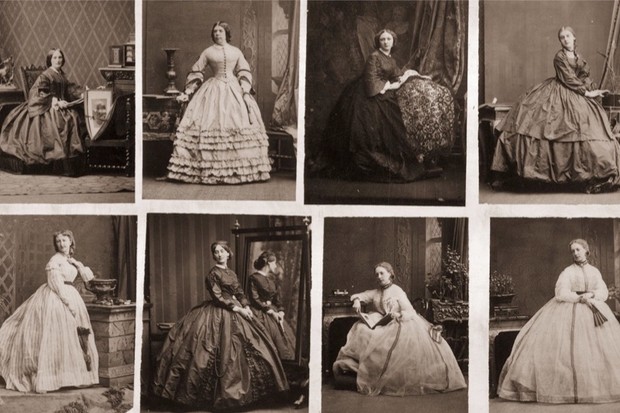
Victorian gowns
The first requirement for victorian gowns was a rigid boned corset. Sometimes it was trendy to wear a crinoline under the skirt, but that must be according to the purpose. Over this, a long flared gown was worn. They had long sleeves mostly. But puffed or bell-shaped sleeves started to become popular over time. Square necklines and high waist were commonly seen among the victorian gowns. During the mid-victorian era, dress designs became more detailed. The embroidered dress became very popular among all the classes. Dress necklines also started to attain elaborate attention, like, ruffled necklines got the most popularity. Sleeves also got heavy decorations.
Victorian evening gowns were the most figurative among the dresses. They always required a petticoat. The skirts were very fancy with many layers and fabulous decorations. All these gowns were well adorned with lace, ribbon, or other fabrics. For the main dress, silk or satin was the best choice.
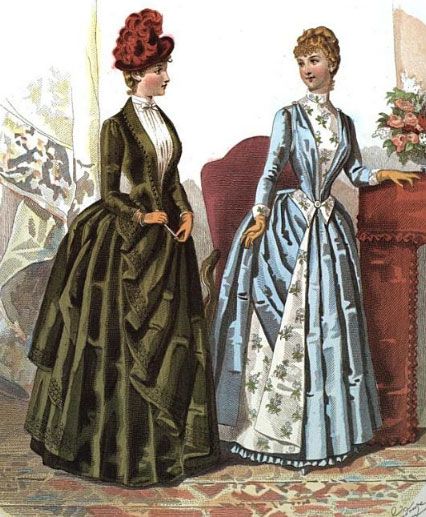
Victorian tea gowns
The 1870s Victorian tea gowns were more like regency gowns. They had draping trains at their back and the front part was decorated with pleats. They looked like elegant bedroom dresses. As the bustle era began, the tea gowns started to adopt the bustle shape. Lighter fabrics were always the right choice for Victorian tea dress. With the absence of corset and delicate details, a Victorian tea party dress was famous as comfortable house party wear. But these parties must be confined in family and close friends. These trends of tea dresses continued to the next Edwardian era. But the Edwardian era saw a more detailed version of tea dresses as this became a popular fashion already.
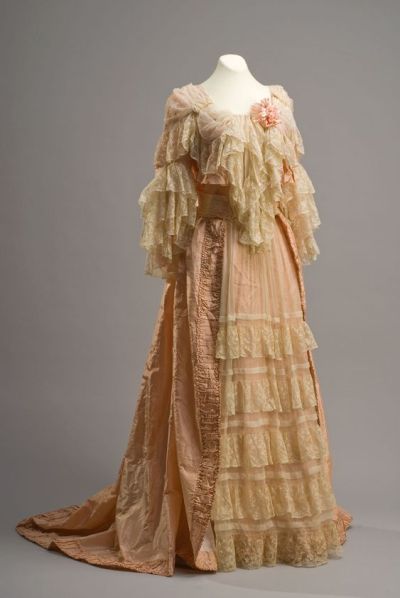
Edwardian Gowns:
The Edwardian era was the time of King Edward which existed from 1901 to 1910, after the death of Queen Victoria. During the Edwardian era, gowns were the commonly used dress for women. The upper class and the powerful people has always been the trendsetter of any society. So, Edwardian gown designs had an influence of King Edward and the royal family. Along with this, there were some fashion designers and fashion houses that designed various kinds of fabulous gowns for them. Lucy Christiana was a famous fashion designer of the Edwardian era. She mainly designed evening gowns and tea gowns. But other gowns of her design were also well known.
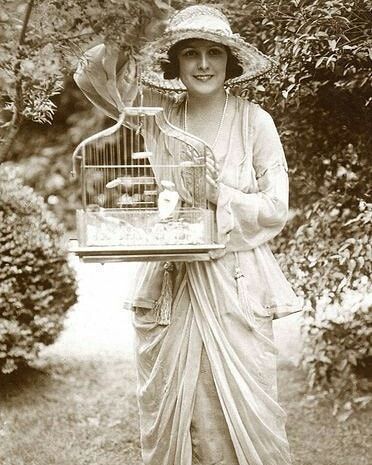
The common thing about Lucy Christiana’s Edwardian gown was its light pastel color. These gowns were very girly and decorative. Almost all of them had different and fabulous ornamentations on them. The focus was on the wearer’s comfort. Although pastel color became the most popular, shades of golden were common choices too. They had various necklines and sleeve designs. The appearance of the gown mostly depended on the silhouette. S curved silhouette was the trending fashion then. This corset emphasized on thinner waist while pushing the shoulders and bust forward. This created an S like posture. Over these corsets, Edwardian gowns were worn which created the desired look for Edwardian women.
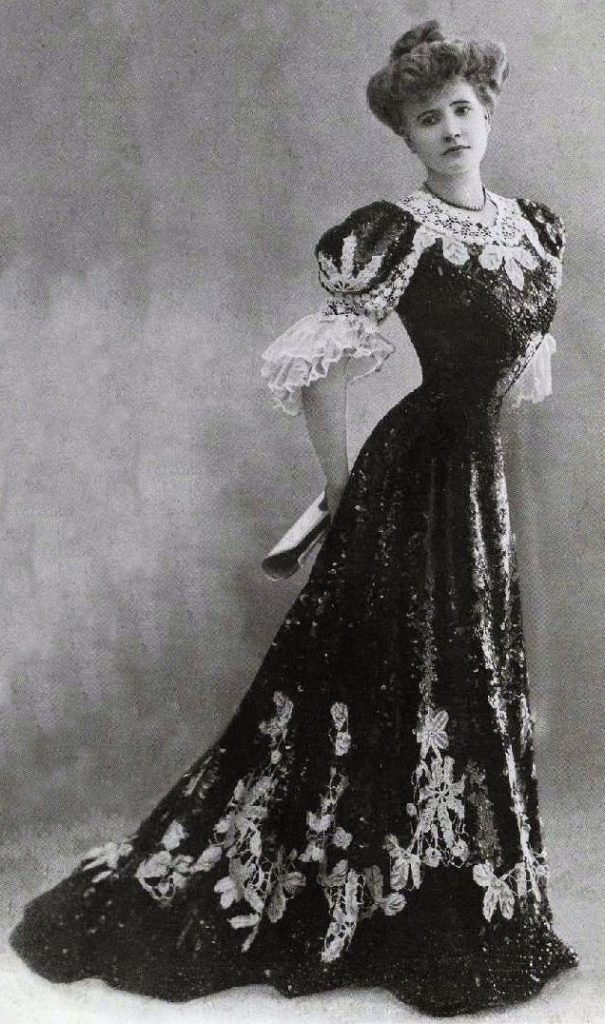
Edwardian Tea gowns
In the evening, wearing a fancy but comfortable dress and having a cup of tea was a common practice among the Edwardian people. This dress is known as the Edwardian tea gown or Edwardian tea dress.
Tea gown was mainly a home or indoor dress. As I mentioned earlier it was worn during the evening while having a cup of tea. Relaxation was the priority in this time so these gowns always ensured the wearer’s comfort. Although corsets were necessary for almost all the dresses in the Edwardian era, tea dresses didn’t require any. Moreover, these dresses had shorter sleeves and more open necklines than the other dresses. Light fabrics were the first choice to make tea gowns. Sometimes a loose chiffon robe or cape was worn over them. Collarless or v-shaped necklines became popular for tea gowns. Soft silks, satins, chiffon, or velvet was the popularly used fabrics.

In the 19th century, these tea gowns consisted of two parts. The lower part was a skirt with a natural waistline. The upper part consisted of a bodice made from the same material as the dress. They had lace or ribbon straps on the shoulder to keep the dress in place. Over this, a lace cape or jacket was worn which showed the delicate lace works of the dress.
Although it was a popular fashion, tea gowns were not meant to be seen in the public. Women wore then inside their house only when they were with family or close friends.
Your tea dress costume idea:
For your tea costume, you can choose anything near your hand. Tea gowns were the most simple dress during the 19th century as they didn’t require any corset as other dresses. You can make your own tea dress following these historical tea dress patterns. If you want a vintage one, there are many online shops that sell these historical tea dresses, so buying online is also an option for you. Otherwise, just grab a silk or satin fabric according to your choice, follow the pattern and make your own tea dress. Later, decorate it with lace or ribbon designs to get a fancy look!
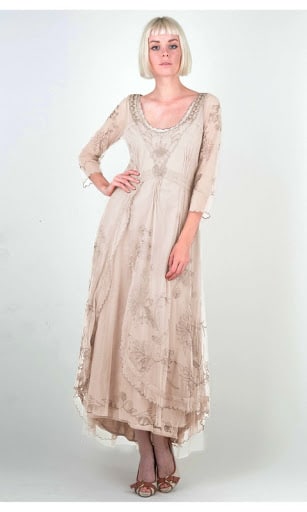
Edwardian Evening gown
Evening dresses were worn in formal events, dinner parties, or ballroom dancing. These dresses were fancier among all. Evening dresses had a great variety of designs and decorations. But they followed the same silhouette as other gowns, the S-curved corset. The earlier Victorian period had an influence on these evening dress fashion. The Edwardian evening dresses were a mixture of many beautiful designs from the previous years.
For the evening dress, the bodice was boned and tight. These corsets had a heart-shaped, square-shaped, or V-shaped opening in the front and a similar V-shaped opening in the back. Both young and mature women fancied a similar silhouette, thin waist with a pushed bosom.
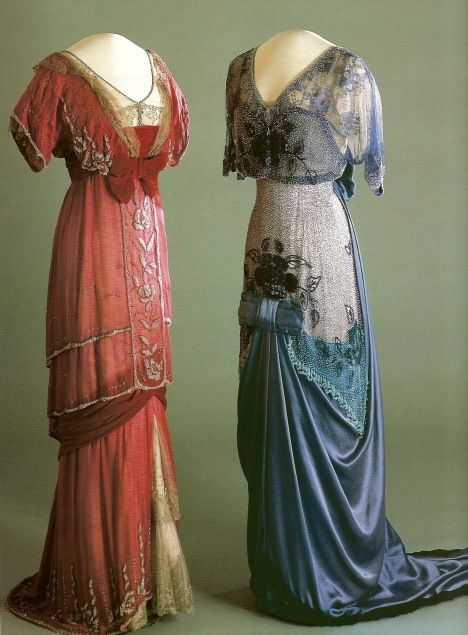
However, the mature women liked to wear long elbow-length sleeves, high lace collars that preserved their modesty. On the other hand, young unmarried women showed more skin. They liked the shorter sleeves and more revealing necklines.
Until 1908, the evening dress skirts were long and floor-length. But in 1911, the hobble skirt arrived and skirts got narrower and shorter. Bell-shaped skirts were adorned by embroideries, lace, applique, or ruffles. After 1909, the s curve was replaced by a tubular column with a high waist which is known as the empire style. Skirts still had many layers.
These gowns usually had light pastel colors like sky blue, yellow, rose pink, lilac, etc. in winter, burgundy, red, blue were popular. Black and white were common throughout the whole decade. After 1909, darker colors started to get more attention.
Edwardian Ball Gowns
Edwardian ball gowns had a similar pattern as the Edwardian evening dresses. In fact, the evening dresses were often used for ballroom dancing. However, some upper-class women custom made ball gowns for special ballroom events. The corset didn’t see any difference from the other dresses. But padding or bust enhancers were often seen to use with ball gowns to enhance the body shape. As women like it gorgeous, the decorations and trims had many variations in Custom-made ball gowns. Although ball gowns followed the pattern of evening gowns, hobble skirts were never an option for ball gowns, as ballroom activities included dancing.
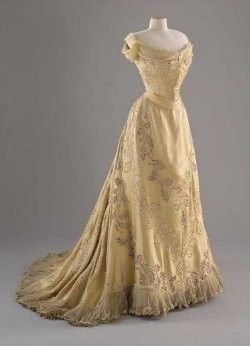
For sleeves, many were seen to use pleats or slits designs. Ruffles, lace designs also became noticeable. Thin strap or cold-shoulder sleeves became popular among young unmarried women. The skirts were bell-shaped and had many layers. For ball gowns, the fancier the better was the motto for all the women.
Edwardian evening or ball gowns were made from rich fabrics like silk, satin, chiffon, tulle, organdy, or lace. Two or more fabrics were usually required for making these dresses. One was used in the bottom and this was the heavier fabric. The lighter one was used for the draping on top. For hotter days, lightweight cotton or linen was used for making the dress. However, all these dresses had heavy and gorgeous decorations.

